In this post I will outline a proven SEO strategy that can get you to 100,000 organic visits per month.
I will give you the action plan to follow in a step-by-step format so that you can replicate it and get results in the fastest possible way.
These are the same steps I’ve followed to increase the traffic for my website to over 120K organic visits per month, in one of the most competitive industries online.
Before we get into the details, let’s look at how my organic traffic improved over the years.

Note: What you see on the left is the number of keywords the website is ranking and it’s not the actual search traffic. What is important to note from this graph is the steady increasing trend in organic traffic.
As you can see in the screenshot above, success did not come overnight. It’s the result of hard work for a number of months.
The good news for you is that you don’t have to wait for months to achieve the same progress.
You don’t even have to wonder or spend your time trying techniques that work only in theory.
It’s not easy. It takes time to successfully execute the plan and a lot of hard work but its proven to work.
Before we get into the actual steps to follow, it’s necessary to understand what do we mean by an SEO strategy and why it is important to have one.
What is SEO strategy? An SEO strategy is a high-level plan of action to achieve higher rankings in search engines for the keywords that matter for your website.
From the above definition you should note two things:
- A strategy MUST include an action plan
- Your ultimate goal is not just to rank for any keywords BUT for the keywords that are important for your website.
What is the Importance of having an SEO Strategy?
If you don’t have a specific blueprint to follow, you will end up ranking for the wrong keywords or with no rankings at all. Either way, this is not what you want.
I always tell my students and clients that doing SEO without a solid plan, is like driving with your eyes closed. You still move forward but it’s a matter of time to hit a wall or engage into an accident.
So, your action plan should focus on how to get higher rankings and traffic for the keywords you want and not for any keywords, and we will see below how to achieve this.
Among other things, in this article I will introduce the concepts of creating pillar articles (Step 5) and building Topical relevancy (Step 6).
Both steps are vital for the successful execution of this strategy.
Let’s dive in.
Here are the 13 steps to follow to make your SEO stronger and improve your search engine rankings.
- Step 1: Get to know your niche and competitors
- Step 2: Get to know your website
- Step 3: Start an SEO Log file
- Step 4: Perform a Technical SEO Audit of your website
- Step 5: Identify for which Keywords to create pillar content
- Step 6: Build Topic Relevancy (supporting articles)
- Step 7: Master On-Page SEO Optimization
- Step 8: Perform a Content audit
- Step 9: Promote your brand online
- Step 10: Create a link-building plan
- Step 11: Stay current on latest SEO practices
- Step 12: Measure SEO results Correctly
- Step 13: Keep your content relevant and up-to-date
Towards the end of the article, you can also get an answer on how long it will take you to get to 100,000 visits per month.
Step 1: Get to know your niche and competitors
For many people this can be a surprising first step but I will explain below why this should be your first course of action.
It is more than certain that hundreds of websites are competing for the same keywords as you.
Some of these websites may have more pages indexed, more content and a stronger link profile.
- Can you complete with them?
- Does it worth to spend time, money and effort to outrank them?
- What is the potential benefit (in terms of traffic), if you get top positions for the keywords you are targeting?
Getting the right answers to the above questions, will help you adjust your SEO strategy accordingly.
For example, after analyzing your competitor’s rankings, you may find out that the traffic for one of your target keywords is less than what keyword research tools are showing.
From my experience this is a very common scenario. Keyword tools tend to get the numbers (search volume) for a keyword wrong, especially for low volume keywords.
What is the problem with that? You will end up targeting keywords that won’t get you the expected levels of traffic and you might be ignoring keywords that can generate targeted traffic.
A better way to get a more accurate picture of which keywords to target, is to analyze the traffic of the webpage that ranks in the first position of Google for a particular keyword.
You can use SEMRUSH (or other similar tools) to find out the rankings and traffic of any website for any keyword.

A correct analysis will give you a better indication if this is a keyword worth targeting.
This finding alone can help you change your strategy and go after other more popular keywords (that you might didn’t know before).
Here is your action plan for this step.
Action Plan
- Use SEMRUSH or your favorite competitor analysis tool and find out which websites rank in the top 5 positions of Google for the keywords you are targeting.
- For each website find out their top-ranking pages.
- For each of their top-ranking pages find out how much traffic they get per keyword.
- Analyze each ranking-page and take note the title of the page, description, type and length of the content.
- Add this information into a spreadsheet (we will use it later in Step 5).
Step 2: Get to know your website
Once you have a clear idea of who you have to compete with, the next step is to create a detailed report about your website.
Why? Knowing where you stand in comparison to your competitors, will help you set up realistic SEO goals.
At this stage what you are looking for is answers to the following questions:
- How much SEO traffic you get per day
- Your most popular landing pages (organic)
- Which keywords drive traffic to your website
- Your ranking position for the keywords you would like to improve
Add this information into a spreadsheet and try to compare your performance with your closest competitors.
If you have a SEMRUSH subscription, you can use the Keyword Gap report to get this information in a table format that is easy to analyze.
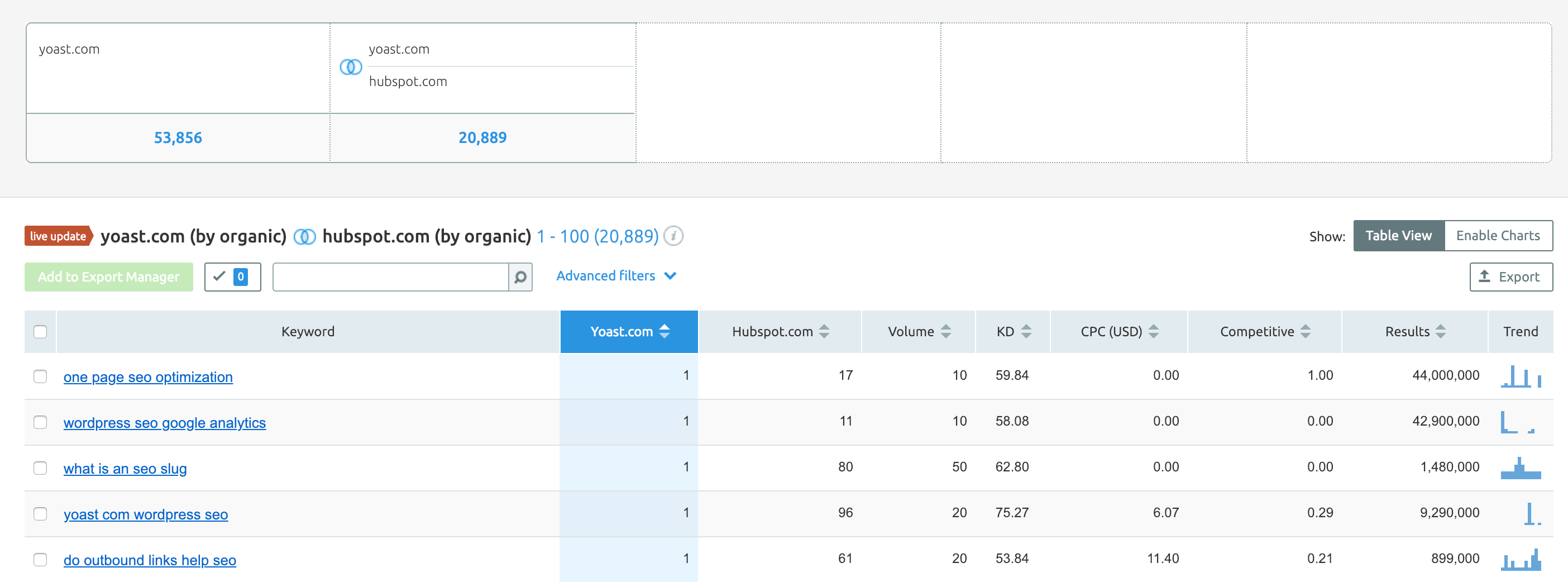
At the end of this step you should have a list of keywords that includes:
- Keywords that you are already ranking high and get traffic
- Keywords that you would like to rank high
- Keywords that your competitors get traffic but you don’t.
Action Plan
- Login to Google search console and using the performance report find out for which keywords you are ranking in Google.
- Use Google analytics to find your top organic landing pages
- Add this information into the spreadsheet created in Step 1.
- Use the Keyword Gap report of SEMRUSH (or any other tool you are using), to compare your rankings with close competitors.
Step 3: Start an SEO Log File
Now that you are past the phase of analyzing your competitors and your website, the next step before start making any changes to your website is to start an SEO Log.
What is an SEO Log? It’s a simple spreadsheet to take note of all SEO related changes you will be making to your website.
Why is this important? SEO takes time to work and the only way to keep track of your changes and their impact on your SEO is to know what you have changed and when.

I use Google sheets for this and my log has a very simple structure (date, SEO change made, comments).
Action Plan
- Create a new spreadsheet (or text file) to record all changes you make to your website.
Step 4: Perform a Technical SEO Audit of your website
The next step is to get your hands dirty and start evaluating the technical SEO performance of your website by performing a technical SEO audit.
What is a technical SEO audit? Is the process to follow to check that the technical SEO infrastructure of your website has no issues.
Through a technical SEO audit, you will ensure that search engines can index your content without any problems.
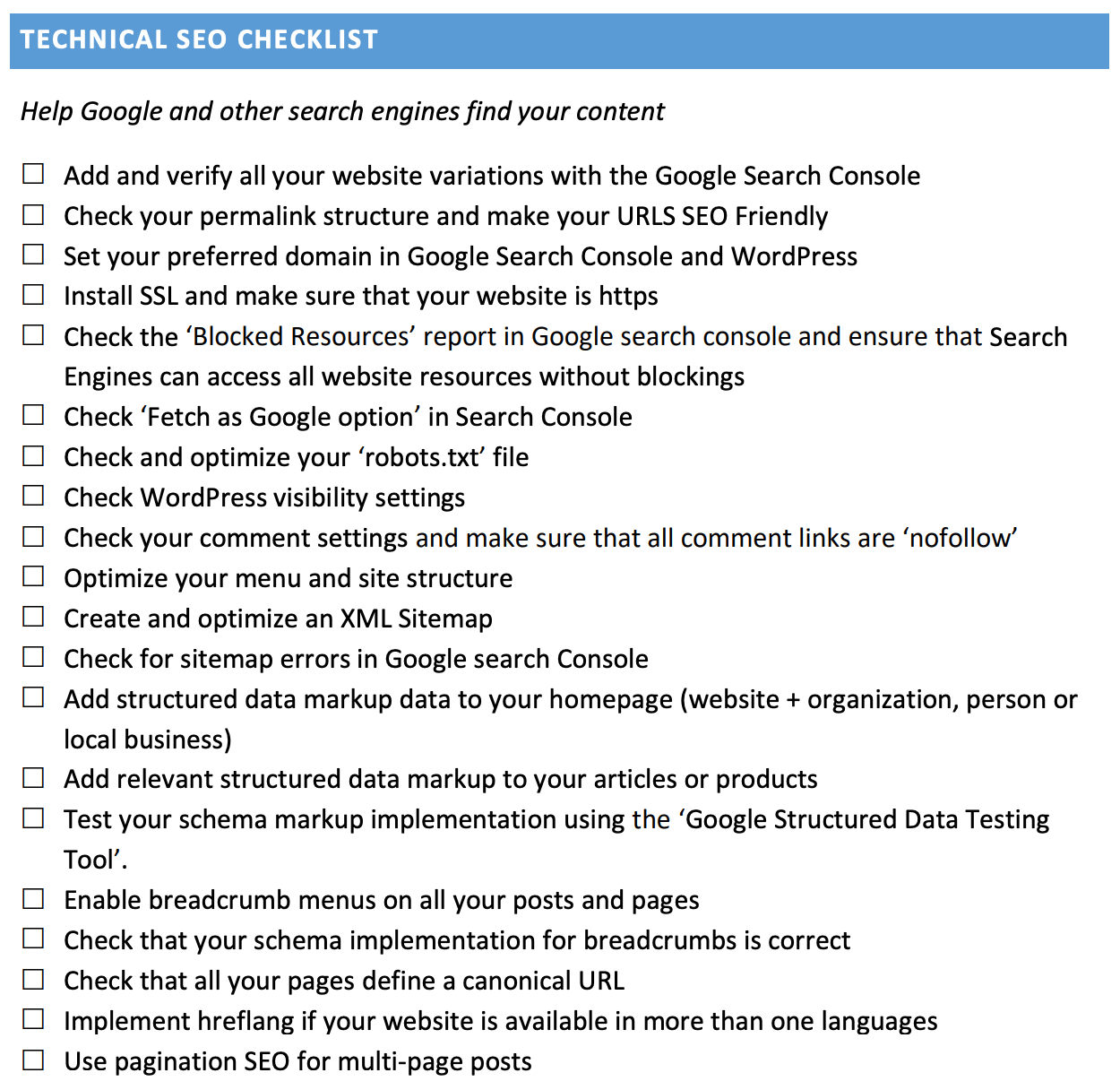
The most important things to check are:
- Crawl errors
- Robots.txt optimization
- XML Sitemap optimization
- Website Speed
- Use of Canonical URLS
- Mobile friendliness
- Correct use of HTTPS
- Correct use of structured data markup (very popular these days)
Don’t worry, you don’t have to be a technical person to do an SEO audit. These three guides can help you pass this step successfully.
Action Plan
- Using the above guides as a guideline, perform a technical SEO Audit of your website.
- Create a list of items that need to be fixed / optimized.
Step 5: Identify for which Keywords to create pillar content
Keyword research is a very important component of your SEO strategy. This is the part to combine the information gathered in Step 1 and Step 2 with a comprehensive keyword research analysis.
Let me explain how this works.
In Step 1 you have identified which keywords bring traffic to your competitors and in step 2 you have identified which keywords bring traffic to your website.
Now, it’s time to use this information and create your master keyword list. The list should include:
- The keywords that you already knew and are important for your business
- Keywords that you didn’t know about but your competitors are getting traffic
- Keywords you are already ranking (and are important for your business)
In other words, your master list has ALL the IMPORTANT keywords you want to rank for.
The next step is to sort the list by volume of traffic. The top 10 Keywords of the list are the most valuable keywords for your business and these are the keywords to use to create pillar content.
What is Pillar content? It’s content that targets a particular keyword (or phrase) and has the following characteristics:
- The content is unique and thorough
- It is linked to from your homepage
- It has internal links from other related articles on your website
- It has incoming links from other websites
- It’s the content you want to rank as high as possible in search engines
- It is well formatted
- It’s content you are really proud off.
- It’s better content that what is already ranking on Google
Why use the concept of having pillar content and not treat all content equally?
The first reason is that you cannot rank for everything you want. The competition is so big for any keyword that is impossible for one website to rank for all the important keywords of a niche.
So, instead of targeting all possible keywords and hope for the best results, you can follow this strategy and increase your chances of ranking for the keywords you really want.
When evaluating a website, search engines are looking for the best available content on the particular website. These are the pages that usually have better rankings than the rest of the website pages.
By giving more attention to specific articles or pages, it’s like giving search engines clues about the keywords you want to be known for.
If this is backed up with social shares, comments and incoming links, you will eventually be able to rank higher for the keywords that are important for your business.
Let me give you a real example to understand the concept of pillar content better.
After doing my competitors analysis and keyword research, I identified that one of the keywords that I want to achieve a high ranking is “SEO Strategy”.
So, my plan to get there is the following:
- Create a thorough and hopefully interesting article that explains how to plan and execute a successful SEO strategy (and thus the article you are reading now).
- Once the article is published, I will link to it from my homepage, add it to my sidebar, add it as a featured article in the SEO articles category, promote it with Facebook Ads and blogger outreach to attract natural links.
- In addition, I will add internal links from existing (related) articles and from new articles I will publish in the future.
My goal is to give all necessary signals to search engines to help them understand that this article is important for my website.
Action Plan
- Create your MASTER keyword list.
- Identify keywords to target with Pillar Content.
- Create a plan to create pillar content articles.
- Create a plan on how to promote your pillar content articles (after publication).
Step 6: Build Topic relevancy – Identify long tail keywords (supporting articles)
In Step 5 you identified the top 10 keywords from your master list and created top-notch content (pillar content) to target each and every keyword in the list.
The next step is to re-analyze those keywords one by one and find long tail keywords you can target.
By doing so, you will be able to:
- Make your pillar content stronger (by adding more internal links)
- Get more search engine traffic since long-tail keywords have less competition and are easier to target.
In addition, it gives you the opportunity to build topic relevancy – something very important if you are targeting high volume competitive keywords.
If you search for any high-volume keyword on Google, and take a few minutes to analyze the top results you will find out that Google tends to rank websites that have a lot of good content about a specific topic (and not just keyword).
For example, if you search for content marketing you will notice that contentmarketinginstitute.com dominates the results.
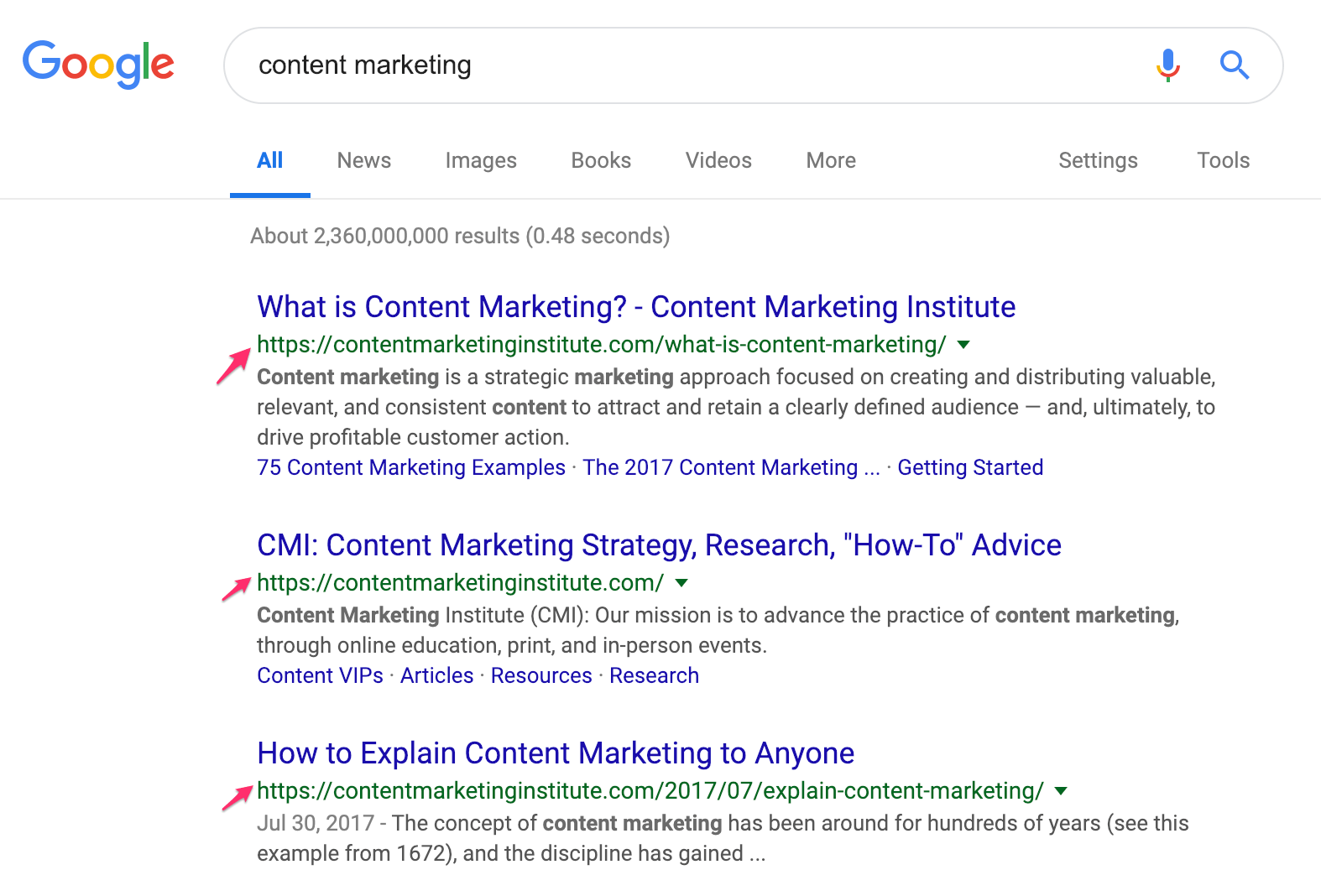
One of the reasons is that over time, they managed to build topic relevancy around content marketing and this helps them rank high for that term and a lot of other related keywords.
Here is the process to follow to find long-tail keywords:
Method 1
Search Google using your target keyword and scroll down to the “People also ask” section and to the “Related Searches”.
For example, if you enter “search engine marketing” into Google you get the following the ‘People also ask section’.

And this in the ‘Related Searches’ section:
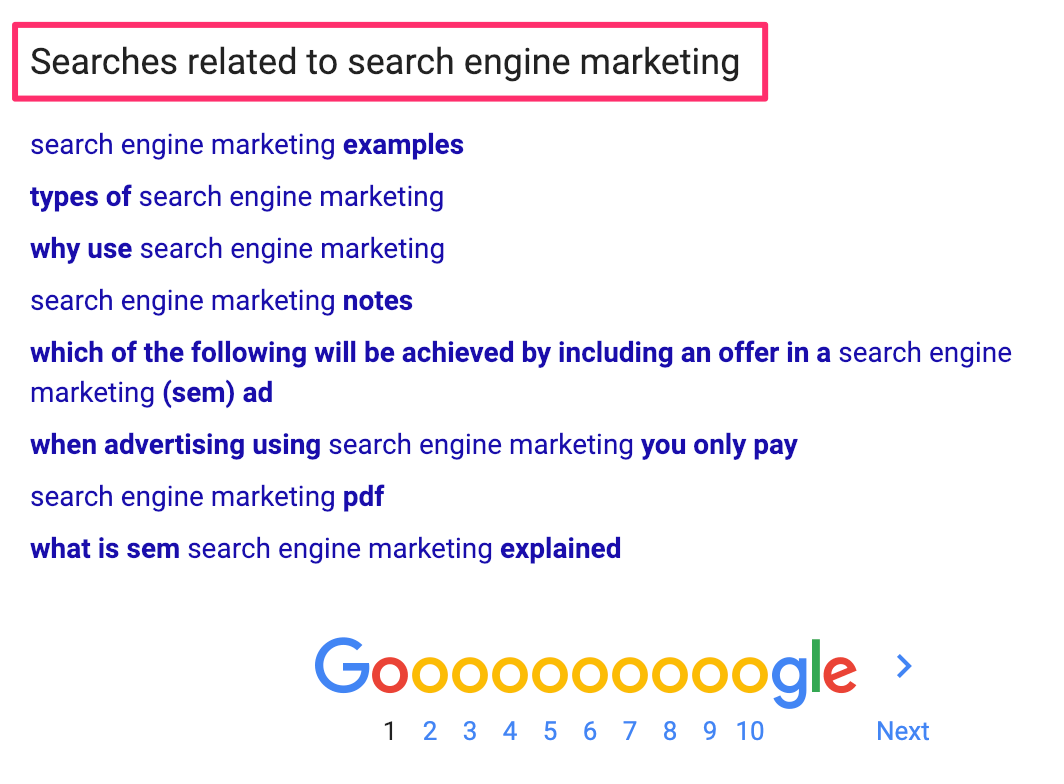
The highlighted search phrases are perfect candidates for creating articles targeting long-tail keywords.
Assuming that you already have a pillar article on search engine marketing, you can add internal links from the supporting articles to make your pillar content stronger.
Method 2
Use the TOPIC RESEARCH function of SEMRUSH.
SEMRUSH is a great tool for keyword research. One of the functions they have is called TOPIC RESEARCH. Basically, you enter a keyword and the tool will give you a lot of ideas of long tail keywords you can target related to your main keyword.
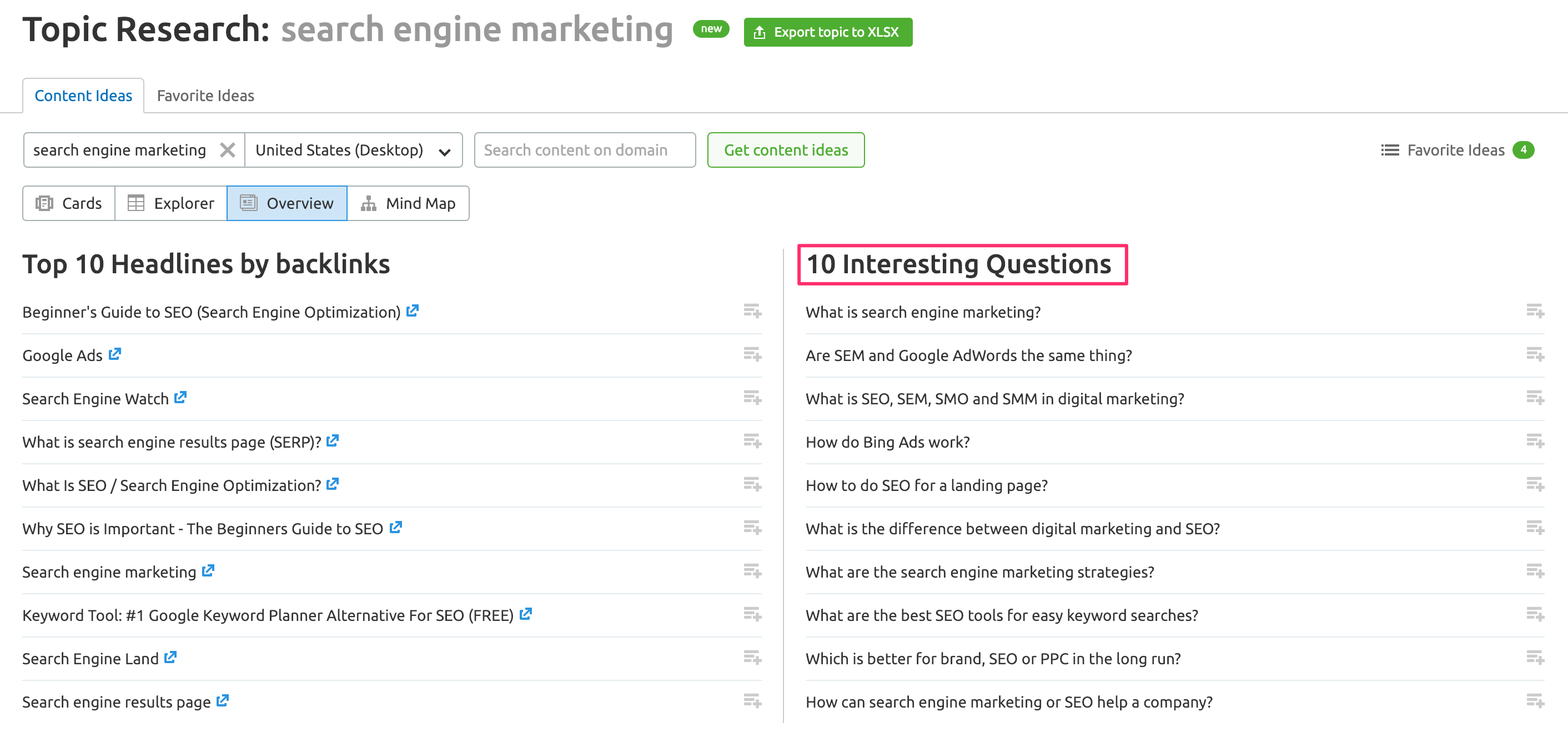
What you should do with the long tail keywords?
- Create articles targeting the different keywords
- In your articles, make sure you add an internal link to your pillar article with a relevant anchor text.
- Promote you articles as usual.
Here is a recap of steps 5 and 6 to make it easier to understand.
- For each of the high traffic keywords that are important for your business, you create a pillar article.
- For each keyword you also identify long-tail keywords.
- You create articles targeting long tail keywords (supporting articles).
- Within the supporting articles, you link back to the pillar article.
Action Plan
- Do your keyword research and for each of your top 10 keywords, find 3-4 long-tail keywords you can target.
- Create a plan to publish articles targeting the long-tail keywords.
- Create a plan to promote your articles.
Step 7: Master On-Page SEO Optimization
While creating content for your pillar and supporting articles, you need to ensure that your on-page SEO is optimized to the fullest.
The primary goal of on-page SEO is to help search engines understand your content and its meaning.
With on-page SEO you deal with things like:
- Optimizing your titles
- Optimizing your meta descriptions
- Optimizing your H1 tag and headings
- Proper usage of keywords within the content of a page
- Image SEO and Video Optimization
- Efficient use of internal links
Action Plan
- Review and optimize your titles and descriptions
- Review all your website pages and optimize your on-page SEO
Step 8: Perform a Content audit
Besides creating new content, one of the tasks you need to perform to make sure that your existing content is in synch with your SEO goals, is a content audit.
A content audit is the process to follow to analyze each and every page of your website and decide whether:
- To remove content
- Improve content
- Re-publish content
- Merge content together
The overall goal of a content audit is to make a website stronger by eliminating pages that have no rankings, traffic, or links.
You can read my previous guide on how to identify thin content but as a general advice, don’t be afraid to remove content from your website if it’s not up-to the standards you want.
Having less but higher quality pages is better than having many low-quality pages.
Action Plan
- Perform a content audit and remove or improve low quality pages from your website.
Step 9: Promote your brand online
If you have reached this point and you are ready to work on Step 9 it means that:
- Your website is optimized for technical SEO
- You have reviewed your on-page SEO
- You have a plan in place for creating pillar content
- You have a plan in place for creating supporting content
- You have performed a content audit and removed all low-quality pages from your website.
This is great! What’s next? Now it’s time to deal with off-page SEO.
Off-page SEO in short refers to SEO techniques that go beyond the content of the website.
To get noticed by Google, you need backlinks and brand mentions.
Let’s start with brand mentions first and deal with link building in step 10.
Why are brand mentions important for modern SEO?
If you ask any SEO expert he will tell you that links are still important for achieving high rankings in Google.
While this is true, there is also a new form of earning the trust of search engine algorithms and this is through brand mentions.
How are brand mentions different from SEO links?
- A brand mention doesn’t necessarily include a link back to your website
- It can happen in any online medium like facebook and other social networks
- The link (if any), can be nofollow.
How can linkless mentions help rankings?
Search engines can identify brand mentions which translates to stronger site authority. It’s not as powerful as high-quality links but it’s a factor considered by all major search engines, including Google.
Gary Illyes (Google Webmaster Trends Analyst) mentioned the effectiveness of brand mentions several times. Here is a quote from his keynote at Brighton SEO:

What does this mean for your SEO Strategy?
Three things:
- You need to track all kinds of brand mentions and try to increase them
- You need to expand your strategy and go after brand mentions and not just links. Social Media networks and guest posting on high authority websites are a great place to start.
- You need to try and convert some of those mentions to links.
Action Plan
- Use a tool to track mentions of your brand across the web.
- Make sure that your brand reputation is high on all networks. Reply to any comments and follow up on any complaints.
- Use an outreach campaign to convert brand mentions to links
- Start guest posting on high authority websites, even if they nofollow the links.
Step 10: Create a link-building plan
While working on your brand promotion, you should also start thinking about links.
I know from experience that link building is one of the most complicated and difficult areas of SEO.
The thing is, you need to get links if you want to get TOP rankings for your target keywords.
This is how it works:
Great content can get you to the FIRST page of Google BUT great content with good incoming links from other websites, can get you to the TOP positions of Google.
You see the difference?
You don’t necessarily need backlinks to have a presence on the first page of Google but you definitely need links to get to the top and get a bigger share of SEO traffic.
How can you get those precious links?
If you search the web for link building techniques, you will get a ton of methods you can use but the truth is, most of them work only in theory.
Think about it this way, why should someone recommend you website to their audience by adding a link in their content? The answer is simple:
- The webmaster should be aware of your website’s existence in the first place.
- It has to offer something great to their audience
What does this mean in simple words?
For someone to link to you, they need to know about you. If you don’t have high rankings in Google for topics they search for and if you don’t actively promote your website in the various social networks they hang out, how can they know that you exist?
This also means that they don’t only need to know about you, but be impressed with your content so that they will naturally recommend it to their audience.
In the SEO World, the recommendation is expressed through a link.
How can you solve these problems?
- By publishing link worthy content – Re-visit the pillar content criteria as explained in Step 5.
- By reaching out to other webmasters, either by email or making connections with them in social networks.
To make this happen, read and follow the step-by-step instructions in these guides:
Action Plan
- Create a link building plan which includes (blogger outreach campaigns, social media campaigns)
Step 11: Stay current on latest SEO practices
SEO practices change all the time. Google deploys thousands of changes per year to their ranking algorithm and it is important to know what is changing and how it might impact your SEO performance.
The best way to get notified of any updates is to follow trusted websites that cover the SEO industry.
I strongly recommend you subscribe to these websites. If there is a new change happening in SEO, you will know about it.
Action Plan
- Subscribe to websites covering the SEO industry to get notified of updates made to the Google algorithms
Step 12: Measure SEO results Correctly
When implementing any strategy, it is important to have a reliable progress tracking system in place.
When it comes to measuring the results of an SEO strategy, you need to ensure that:
- You have an accurate picture of your rankings and traffic before starting the implementation of your plan.
- You have an SEO Log (Step 3 above), to track ALL changes made to your website
- You are measuring the right KPIs.
It is essential that you keep track of the dates Google is deploying changes to their ranking algorithm and analyze the impact by comparing your SEO statistics before and after the changes.
Action Plan
- Familiarize yourself with key Google Analytics reports
- Don’t forget to update your SEO log with all changes made to your website
- Keep track of Google algorithmic changes
- Analyze your rankings and traffic before and after any change
Step 13: Keep your content relevant and up-to-date
One of the secrets of growing your organic traffic steadily is to keep your content relevant and up-to-date.
Once you get a good ranking for a keyword, it is not guarantee that you will keep this ranking forever.
Hundreds of websites are targeting the same keywords, so you need to ensure that your content is always relevant and up-to-date.
Don’t just focus on creating new content but go back and do a quality check of your existing content.
Action Plan
- Create a plan to review and improve your pages that already have a high ranking in Google and ensure that their content is accurate and up to date. You should do this at least twice per year.
How long to get to 100,000 visits per month?
If you follow the above steps, it is almost guarantee that your SEO traffic will increase steadily over time.
How long it will take to get to 100,000 organic visits per month depends on how big your niche is.
If you are going after TOPICS that have a lot of monthly searches, then it is likely to reach your goal sooner, provided that you follow the plan correctly and consistently.
If you are in a less popular niche, you should consider expanding your reach so that there are more topics and keywords to target.
You can use tools like Google Trends to find out how the search intent is changing over time and try to be there before your competitors.
As a final word, always remember that search engines are struggling to keep their users happy so if you want to maintain or gain rankings, you need to give search engine users what they want and keep them satisfied.





I never ever read that type of actionable blueprint on SEO…
I am going to use in my blog to getting more search traffic from Google…
Thanks for your Amazing SEO framework.
Cheers.
Bishnu.☺️
Hi Bishnu
Thanks a lot. All the best with your SEO Efforts.
Alex
This article is very detailed and informative on this topic, thanks for sharing!
i am going to use this plan to get more traffic for my website,
thanks for sharing great article.
Hey Alex, I would like to say thanks a Lot for sharing this Valuable information with us. It seems Really very informative.
Appreciate the topic and the detail in this article.
I prefer your approach, Alex, of assigning the goal of Increasing Traffic, rather than promising leads which may or may not materialize.
SEOers doing that do both the client and themselves a disservice!
I have read over a hundred post on seo and over 50 videos but I have never learnt anything in depth and beneficial like this post. Thanks so much. God bless.✌
It’s a very interesting blog. Now it’s something I’m searching on the Internet. Thanks for this blog post, it will help me a lot to generate 100K user traffic per month.
Really nice article with useful SEO information.
Thank you very much.
Hello Alex,
SEO seems to be a constantly changing world. Google changes its algorithm more often. We have to work thoroughly on our on-page SEO and Off-Page SEO to leverage good ranking in search engine result page. Thanks for sharing these helpful tips and SEO insights.
Regards,
Vishwajeet
Thanks for sharing the strategy of SEO for boosting a website. I, ll definitely try it for my website. I think that it will work for boosting my website.
This post was EPIC. I spent an hour carefully reading through it, and checking out all of the different sites and tools you recommended throughout the article. This post is as good as most books about blogging and content marketing, in my opinion. Bookmarked & shared. Thanks again!
Thanks for sharing your knowledge with us. It is really helpful.
Awesome article. You have explained beautifully all the strategies to get the organic traffic.
good work, it’s valuable information for learning SEO marketing and boost the traffic of your website. Thanks for sharing these actionable tips. Appreciate your efforts.
Extremely Great work, Thanks for offer helpful data. the posts on your blog are having enlightening and important substance.content with proper keyword research attract right audience. Thanks for providing me actionable tips. Appreciate your efforts.
Great Alex,
Thank you for such informative stuff on SEO. These strategies will work to drive the organic traffic on your website. It also helps to boost the ranking. If you properly handle the SEO according to the Google guidelines, you will surely rank your website.
Such an in-depth article. All 13 steps are really easy to follow. I’ve just built up my website and haven’t got much traffic. I think these tips will help increase the website’s organic sessions.
This article is very detailed and informative on this topic, thanks for sharing! i am going to use this plan to get more traffic for my website,
thanks for sharing the great article.
Cheers
Steven Smith
Hi, your article was nice and good. Thanks for sharing the worthful information and content
I am going to use this plan to get more traffic for my website .
Nice content Alex now I can set an SEO strategy for my website once again Thanks.
Great article, really helpful.
Thanks!
Excellent post and I loved the way you explained every small point with proper pictures and example. thanks for sharing the post and keep touch with us
Thanks for an awesome read.
This post was EPIC. I spent an hour carefully reading through it, and checking out all of the different sites and tools you recommended throughout the article. This post is as good as most books about blogging and content marketing, in my opinion. Bookmarked & shared. Thanks again!
Very deeply explained about SEO and organic traffic…!!!Everyone needs traffic source now a days either for business or personal use.
I think you shared an effective guidelines for SEO Strategy to get to 100K.
I really appreciate your effort for giving such information to your community. I think the create pillar content part is really important when you communicating with your followers.
Expecting more information related to this post. Appreciated !!